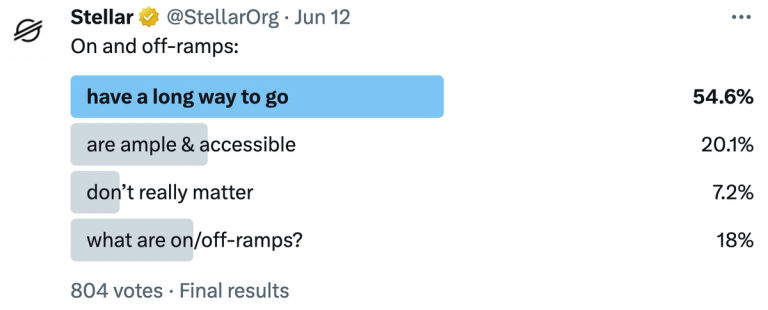Blog Article
The Poll That Made Us Spiral: On and Off-Ramps
Author
Carolyn Yi
Publishing date
On and off-ramps
Cash-to-crypto
Recently, we (intentionally) threw a poll out on Twitter without much context.

At SDF, we talk about on and off-ramps all the time – internally and within the industry – with the assumption that we’re all on the same page about their role and importance. But as this quick poll revealed, there are noteworthy differences in awareness and opinion from our audience about the state of on and off-ramp infrastructure and how much they matter.
Let’s address this, starting with how we define on-ramps and off-ramps.
- An on-ramp lets you exchange fiat currency (such as US dollars) for crypto.
- An off-ramp lets you exchange crypto back to fiat currency.
- In short, on and off-ramps are there to help you convert between fiat and crypto.
So why do on and off-ramps matter?
They matter because they solve a problem: people need ways to move value between the traditional financial system and the decentralized financial system. Value of any kind is only useful if people can actually use it when they need to by moving it from point A to point B.
Value flows all around the world, for many reasons, and with many intended destinations. Within the traditional financial system, the speed and cost at which that value moves can depend on many different things: who you are, where you live, and what systems and financial tools are available to you.
Thankfully, a growing number of fast and accessible financial services are powered today by blockchain and crypto, including sending and receiving cross border payments, peer-to-peer payments, and buying and exchanging crypto. In order to leverage these services, you need to be able to enter the digital economy, take advantage of these services available to you, and then importantly, easily exit and convert back to cash if and when you want.
This is where on and off-ramps come in, but the on and off-ramp infrastructure that makes the crypto economy accessible is still full of potholes and roadblocks. Some level of friction still exists for most people, to varying degrees. And to date, on and off-ramp services have been scarce and mostly available only to people with bank accounts and credit cards (though there are solutions working to change that).
Crypto is often touted as democratizing access to financial services for underbanked and unbanked people worldwide, but much of the world – roughly 2 billion workers in the informal economy, or over 60% of the world’s adult labor force – don’t have access to the financial tools that are still often required to easily access crypto. To them, they’d prefer cash because they can use cash in most situations.
Ultimately, regardless of who you are and what level of financial access and privilege you have, the path your value takes to get from point A to point B is not as seamless or inclusive as we’d hope in 2023. If decentralized finance is to be more accessible than traditional finance, it is critical that on and off-ramps serve everyone, from rural areas and hard-to-reach regions, to those that are cash-dependent and operating outside the current system.
In order to take the financial system into the future, we all have to dedicate effort and resources to building the infrastructure that will make this possible. And at SDF, we believe that infrastructure = ramps!
So we want to dedicate some room on our channels to discuss them. Over the next couple weeks, expect to engage with content about how the ecosystem is working to provide better answers to the existing on and off-ramp problem.
And who knows, maybe we’ll bring that poll back sometime and see if anyone’s opinions have changed.